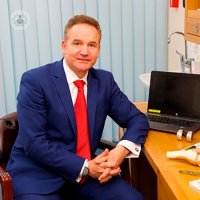Realigning your knees with the bilateral HTO procedure: benefits, risks and recovery
Autore:Bilateral HTO (high tibial osteotomy) corrects the alignment of both your knee joints, relieving symptoms such as knee pain and stiffness and preventing possible further damage to your joints. If you are a particularly active person and want to maintain your level of activity, then this surgery would be a good choice.
Mr Matt Dawson is a leading orthopaedic surgeon specialising in sports injuries and degenerative conditions. Outside of Japan, he also has the most extensive experience of bilateral osteotomy surgery anywhere in the world. We spoke to him about this procedure to give us a quick overview of the risks and benefits and what you can expect if you choose to undergo this treatment.

When is a bilateral HTO performed?
High tibial osteotomy (HTO) is a surgical procedure that realigns the leg to redistribute your weight across the knee and protect the damaged part of the joint. It is typically done to preserve the inner part of the joint and to relieve symptoms such as pain and stiffness in the knee.
Osteotomy is usually used to treat osteoarthritis, however, it can also be considered if there are other types of damage such as ligament injury.
If you are experiencing knee pain and stiffness when you are playing sports, then this procedure can help fix this problem and allow you to continue playing sports without further damaging your knees. It can also help to reduce your chances of having to undergo a knee replacement later down the line.
Can both knees be operated on at the same time?
Yes, this is known as a bilateral HTO and can be offered if you are experiencing symptoms in both knees. By operating on both sides during one procedure, it reduces your overall recovery time.
What happens during a bilateral HTO?
During bilateral HTO surgery, incisions are made at the top of the shin bones and bone grafts of a specific size are fitted into a gap created by opening a wedge shape. The new alignment is then fixed with titanium surgical plates. The entire procedure is carefully planned beforehand so that we can ensure your weight is evenly distributed across the joints.
What is recovery like from a bilateral HTO?
You will have to spend at least two nights in the hospital after undergoing a bilateral HTO. You will also need to use a wheelchair once you go home for up to 4 weeks. In addition, we can provide you with a banana board: a yellow lightweight, curved board to help you transfer yourself while in a seated position from one place to another.
You will not be able to put full weight through your legs for the first 4 weeks, so the use of specially designed crutches will help you get around and make short distances. You should use these for at least 8 weeks and avoid any manual-style work for 3-4 months. Physiotherapy is highly recommended and a very important aspect of your recovery. Therefore, you should try to schedule this even before undergoing the operation.
You can expect to return to all of your usual daily activities including playing sports after you have fully recovered. It is important to note that even though you may experience quicker pain relief during the recovery from a total or partial knee replacement, the overall benefits of HTO far outweigh the benefits of a knee replacement in terms of levels of activity and flexibility you can achieve after recovery and preservation of the knee joint in the medium to longer term.
What are the risks and benefits of this procedure?
As with any surgery, there are always small risks of complications occurring. This may include infections, blood clots and adverse reactions to the anaesthesia. There are a number of significant benefits from undergoing a bilateral HTO which should be noted:
- The operation helps to relieve significant pain and stiffness in the knee joint.
- The pressure placed on the knee joint is reduced, which should consequently reduce the chances of further damage to your bones and cartilage.
- Correcting both knees can help to improve your stride and correct bow legs - where the legs curve outwards at the knees.
Mr Matt Dawson is available for both face-to-face appointments and video consultations. To make an appointment with him to discuss more this procedure, visit his Top Doctors profile and check his availability.


